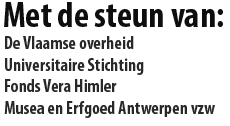A. VAN DER ZEIJDEN
Vrouwen in de volkskunde ten tijde van het Interbellum: de factor gender in de wetenschapsbeoefening
Summary: Women folklorists in the interbellum period : the factor “gender” in practising science
Men completely set the sence in recent surveys of the history of folklore in The Netherlands and in Flanders. Is this conclusion in line with reality, or is it a matter of “genderbias”, in which the work of female folklorists is systematically underestimated? By studying the contributions of five female Dutch folklorists in the interbellum period, the author investigates to what extent the factor “gender” influenced their choice of subject matter, their philosophy of science, and their careers. He concludes that masculinity and feminality played a crucial role in the approaching and the appreciating of their contributions to folklore.
,
G. SPIESSENS
Jan-Baptist Halbos en zijn bundel “Duytsche Liedekens” (1663)
Summary: Jan-Baptist Halbos and his music book Vermaeckelycke Duytsche Liedekens
The music book Vermaeckelycke Duytsche Liedekens (Antwerp, heirs Phalesius, 1663), of which only the base part is conserved, is an anthology of Flemish/ Dutch songs. The collector was Jan-Baptist Halbos, an Antwerp tradesman and music lover, who sung in the citadel church. He dedicated his book to Adriaen van Alphen, an canon of Saint-Peters church in Turnhout. In 1663 Maria Phalesia also printed a second edition of a music book by Maurizio Cazzati and dedicated it to Halbos, who probably supported her financially. The twelve settings for three and four voices are by three Antwerp composers: Philips Van Steenlant, Jacobus Le Febvre, Henricus Liberti, and an anonymous one. The subjects of the vernacular texts are connected with a theatre play, witch the raise of the Valenciennes siege, Saint-Cecily’s feast, Shrove Tuesdag, a wedding, a farewell, drunks and the treetcries of Antwerp. A tirtheenth song, i.e. a four part motet about the Latin declinations, by the Italian Tarquinio Merula is a supplement to the collection.
,
W.L.BRAEKMAN
Mysterieus 17de-eeuws Engels transformatiespel
Summary : Mysterious 17th-century English transformation game
A rare, colourful 17th century MS. Of uncertain use in the Fuller collection of the BL, is here drawn attention to for the first time. It is a document probably unique of its kind, presumably some sort of educational game. It consists of a single vellum leaf, vertically divided into eight strips. Each of these has a top and a bottom part folded respectively up or down. When opened or shut, each part reveals an ever changing drawing which is accompanied by a set of English verse.
The produce for revealing each of the combined figures is described here in detail, in the hope that someone else can shed light on the nature of this puzzling game and its exact purpose.
,

